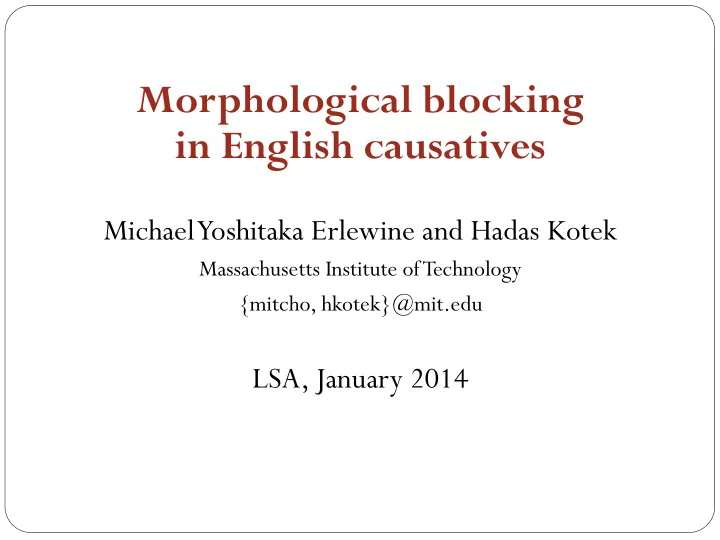

Morphological blocking in English causatives Michael Yoshitaka Erlewine and Hadas Kotek Massachusetts Institute of Technology {mitcho, hkotek}@mit.edu LSA, January 2014
Today Morphological blocking occurs when the existence of a lexically specified form “blocks” a rule derived form: curious → ✓ curiosity glorious → *gloriosity, but ✓ glory A novel paradigm of blocking in English causatives. Such a pattern of causative blocking has been well studied in Japanese, but believed not to occur in English. An analysis in the framework of Distributed Morphology. Consequences for theories of morphology. 2
Background: Blocking effects in Distributed Morphology 3
The blocking effect (1) The past tense paradigm a. walk + [ PAST ] → walked b. bend + [ PAST ] → bent , * bended Traditionally, blocking is thought of as the result of competition between words (Aronoff 1976 a.o.) . A “simpler” form is preferred to more complex, rule-derived ones. (2) The comparative paradigm a. intelligent + [ COMP ] → more intelligent b. smart + [ COMP ] → smarter, *more smart Words and phrases can participate in a blocking paradigm (Poser 1992) . A challenge for the lexical competition view. 4
Distributed Morphology A syntactic approach to word-formation. Late insertion of phonological material into terminal nodes. There may be several ways of spelling out the same node: (3) Vocabulary items for past tense (T[ PAST ]) : ↔ - t / { √ leave , √ bend , ...} ___ a. T[ PAST ] b. T[ PAST ] ↔ ∅ / { √ hit , √ quit , ...} ___ ↔ - ed c. T[ PAST ] If multiple rules can apply, the most specified one is used. 5
Blocking in Distributed Morphology “Blocking” is caused because Vocabulary Insertion can apply only once for each terminal node. T[ PAST ] ↔ either - t , - ed , or ∅ . T[ PAST ] ↔ - t in the context of √ bend “blocks” realization with - ed . The form bended is never generated. (4) Rules Apply (Embick and Maranz 2008) : Perform a computation when the structural description of the rule is met. If a rule of affixation can apply in a particular structural context, it must apply. With [ COMP ] affixed to √ smart , it realizes “ smarter. ” “ more smart ” is never generated. 6
Blocking effects in causatives 7
Japanese causatives: Form Two ways of forming a causative: (5) Two causative forms for narab - ‘line up’ : a. lexical : narab-e- b. analytic : narab-ase- Lexical causatives are specified in the lexicon, unproductive. Analytic causatives are rule-derived, productive ( -(s)ase ). 8
Japanese causatives: Meaning The two causatives correspond to two different meanings: (6) Lexical causative form = causation semantics: Kyooshi-ga kaado-o kyootaku-ni narab- e -ta. teacher- NOM card- ACC teacher’s desk-on line up- CAUSE - PAST ‘The teacher arranged the cards on the teacher’s desk.’ Causation : the (primarily physical) actions of the subject bring about the described state of affairs. Compatible with all kinds of causees. With an animate causee, e.g. the students , the sentence is judged as semantically odd. 9
Japanese causatives: Meaning The two causatives correspond to two different meanings: (7) Analytic causative form = compulsion semantics: Kyooshi-ga seito-o kootei-ni narab- ase -ta. teacher- NOM student- ACC schoolyard-in line up- CAUSE - PAST ‘The teacher made the students line up in the schoolyard.’ Compulsion : the subject puts the causee under an obligation. Compatible with animate , volitional causees (cf Shibatani 1973 for Japanese, among many others) . Incompatible with inanimate causees, e.g. the cards . 10
Blocking effects in Japanese causatives (8) Causatives with inanimate causees: Kyooshi-ga kaado-o kyootaku-ni narab-{ ✓ e /* ase }-ta. teacher-NOM card-ACC teacher’s desk-on line up- CAUSE - PAST ‘The teacher arranged the cards on the teacher’s desk.’ Because the causee is inanimate, it must be a causation meaning. Causation meaning → narab-e- (lexical), * narab-ase- (analytic) à This is blocking! Blocking only occurs if the verb has a lexical causative specified. If the verb does not have a lexical causative form, analytic causative form ( -sase ) can be used with causation meaning. 11
Blocking effects in Japanese causatives Two kinds of causatives and two types of causees: Lexical/analytic causative Animate/inanimate causee (9) For verbs with a lexical causative form specified: a. ✓ [inanimate causee] … [lexical causative] b. # [animate causee] … [lexical causative] ß blocked! c. * [inanimate causee] … [analytic causative] d. ✓ [animate causee] … [analytic causative] This Japanese blocking paradigm has been very well studied. It has been believed that such blocking does not occur in English. 12
English causatives Two ways of forming a causative: (10) Two causative forms for bounce : a. lexical : bounce ( verb ) b. analytic : make bounce ( make verb ) Lexical causatives are specified in the lexicon, unproductive. Analytic causatives are rule-derived, productive. 13
English causatives At first glance, English does not parallel the Japanese behavior. (11) The four-way paradigm: a. The coach bounced the ball on the floor. b. # The coach bounced the gymnast on the floor. c. The coach made the ball bounce on the floor. d. The coach made the gymnast bounce on the floor. With an inanimate causee, “ make … bounce ” is not blocked. 14
English causatives F However, the Japanese paradigm emerges when the causee is moved out of the way. (12) The four-way paradigm with movement of causee: a. That’s the ball that the coach bounced on the floor. b. # That’s the gymnast that the coach bounced on the floor. c. * That’s the ball that the coach made bounce on the floor. d. That’s the gymnast that the coach made bounce on the floor. 15
Recommend
More recommend